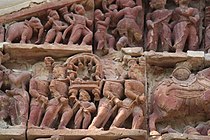Bhalia
Geography

5miles
River
River
River
River
Bayara
Location
Bhalia is located at 22°53′47″N 87°51′44″E / 22.8963°N 87.8623°E
Area overview
The Arambagh subdivision, presented in the map alongside, is divided into two physiographic parts – the Dwarakeswar River being the dividing line. The western part is upland and rocky – it is extension of the terrain of neighbouring Bankura district. The eastern part is flat alluvial plain area. The railways, the roads and flood-control measures have had an impact on the area. The area is overwhelmingly rural with 94.77% of the population living in rural areas and 5.23% in urban areas.
Note: The map alongside presents some of the notable locations in the subdivision. All places marked in the map are linked in the larger full-screen map.
Demographics
According to the 2011 Census of India, Bhalia had a total population of 2,452 of which 1,241 (51%) were males and 1,211 (49%) were females. Population in the age range 0–6 years was 265. The total number of literate persons in Bhalia was 1,690 (77.27% of the population over 6 years).
Culture
David J. McCutchion mentions the Raghunatha temple of Sarkar family as an at chala with porch on triple archway, built in 1772 and measuring 24’ x 23’.
Bhalia picture gallery
-
Raghunatha temple of Sarkar family, at chala, built in 1772
-
Terracotta relief in Raghunatha temple
-
Terracotta relief in Raghunatha temple
References
- ^ "District Census Handbook: Hugli, Series-20, Part XIIA" (PDF). Physiography, Page 17-19. Directorate of Census Operations, West Bengal, 2011. Retrieved 25 September 2020.
- ^ "District Statistical Handbook 2014 Hooghly". Table 2.2, 2.4(a). Department of Planning and Statistics, Government of West Bengal. Retrieved 25 September 2020.
- ^ "2011 Census – Primary Census Abstract Data Tables". West Bengal – District-wise. Registrar General and Census Commissioner, India. Retrieved 22 September 2020.
- ^ McCutchion, David J., Late Mediaeval Temples of Bengal, first published 1972, reprinted 2017, page 35. The Asiatic Society, Kolkata, ISBN 978-93-81574-65-2


